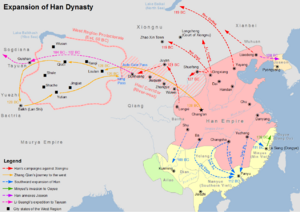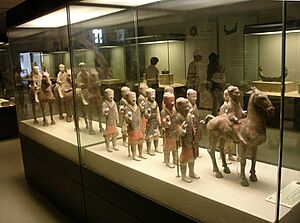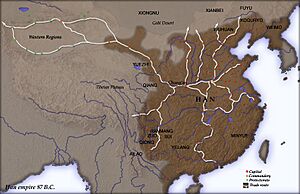Han campaigns against Minyue facts for kids
Quick facts for kids Han campaigns against Minyue |
|||||||
|---|---|---|---|---|---|---|---|
| Part of the southward expansion of the Han dynasty | |||||||
 Map showing the expansion of Han dynasty in the 2nd century BC |
|||||||
|
|||||||
| Belligerents | |||||||
| Han dynasty | Minyue | ||||||
| Commanders and leaders | |||||||
|
138 BC Yang Pu Wang Wenshu Two marquises of Yue |
135 BC |
||||||
The Han campaigns against Minyue were a series of three military actions by the powerful Han dynasty against the smaller Minyue state. These campaigns happened between 138 BC and 111 BC. The first campaign began when Minyue attacked a neighboring state called Eastern Ou in 138 BC.
Later, in 135 BC, the Han stepped in to stop a war between Minyue and Nanyue. After this, Minyue was split into two parts: Minyue and Dongyue. A Han-supported king ruled Minyue. However, in 111 BC, the ruler of Dongyue, Zou Yushan, rebelled against the Han. The Han dynasty quickly put down this rebellion. They then took full control of both Minyue and Dongyue. This brought these lands permanently into the Han Empire.
Contents
How It Started
The Qin dynasty first expanded into southern China. This expansion continued under the Han dynasty. After the Qin dynasty fell, the Minyue kingdom was formed in 202 BC. Eastern Ou was created in 192 BC. The Han dynasty supported both kingdoms. They were given more freedom because they helped fight against the Qin. The local leaders of Minyue also supported the Han leader Liu Bang. They chose him over Xiang Yu of the Chu state during a civil war.
Minyue was created from a former Qin area called Minzhong. Its capital was Dongye. Zou Wuzhu became its first ruler. Ten years later, Zou Yao was given control of Donghai. This area was also known as Eastern Ou, named after its capital. The Han emperor said that "Zou Yan, the chief of Min, achieved great merit." This meant he did something very good. The Han historian Sima Qian wrote that both rulers were descendants of Goujian. He was a famous ruler from the 5th century BC. Their family lost their royal status during the Qin wars. They became local chieftains instead.
Han-Minyue Conflicts
Why Minyue Fought
Historians from the Han dynasty often said Minyue attacked its neighbors just because its king, Zou Ying, was "foolhardy and greedy." However, some modern historians see it differently. They believe Minyue's attacks in the 130s BC were actually "pre-emptive strikes." This means Minyue was trying to attack first to stop the Han from taking over their land. They wanted to protect their independence from the growing Han Empire.
First Han Action

In 138 BC, Minyue attacked Eastern Ou. Eastern Ou then asked the Han dynasty for help. The Han court was not sure what to do. Some officials, like the commander-in-chief Tian Fen, argued against helping. He said that wars between the Yue tribes happened often. He felt it was not the Han government's problem.
However, the idea of China being the center of the world changed their minds. According to Chinese beliefs, the emperor, or "Son of Heaven," had a special duty. This duty was to help smaller countries in need. As the Han official Zhuang Zhu put it, "how could we treat the myriad kingdoms as our children?" So, the Han decided to send an army.
A Han naval force, led by Zhuang Zhu, sailed from Shaoxing. They were heading towards Minyue. But Minyue surrendered before the Han troops even arrived. They pulled their forces out of Eastern Ou. There were also plans to move the people of Eastern Ou. They would be moved to an area between the Huai River and Yangtze River. This was at the request of the king of Eastern Ou.
Second Han Action

In 135 BC, a new war started when Minyue attacked Nanyue. Zhao Mo, the king of Nanyue, asked the Han for military help. The Han agreed to help. Zhao had offered to become a vassal (a ruler who owes loyalty to a more powerful one) in 180 BC. The Han had accepted this because Zhao had roots in northern China.
An army, led by generals Wang Hui and Han Anguo, was sent to invade Minyue. However, the campaign ended quickly due to problems within the Minyue royal family. The younger brother of the Minyue king Zou Ying, named Zou Yushan, was worried about the Han invasion. He worked with the royal court to remove his brother from power. Yushan killed his brother, and the Han forces soon pulled back.
Zhao Mo was very thankful for the quick help against Minyue. The Han official Zhuang Zhu met with the Nanyue emperor, who showed his gratitude. Zhao sent his son, Prince Zhao Yingqi, to the Han capital, Chang'an. There, he would work for the Emperor. After this campaign, Minyue was split into two separate kingdoms: Minyue and Dongyue. The Han controlled Minyue through a king they chose. Dongyue was ruled independently by Zou Yushan, the brother who had killed the former king.
Zou Chou was chosen to be the Han-supported ruler of Minyue. This was because he was the only royal family member who did not fight against Nanyue. However, he struggled to control the people of Minyue. They preferred to be loyal to Zou Yushan instead. Yushan then declared himself king of Minyue without the Han emperor's permission. The emperor, Emperor Wu, learned of Yushan's actions. He recognized Yushan as king of Dongyue instead of invading again. Emperor Wu saw it as a reward for Yushan killing Zou Ying and ending the war. This assassination saved the Han from spending more resources. Dongyue had a difficult relationship with the Han. In 112 BC, Han officials were killed in a fight with Dongyue.
Final Campaign and Takeover

As Han troops returned from the Han–Nanyue War in 111 BC, the Han government discussed taking over Dongyue. Dongyue, led by King Zou Yushan, had agreed to help the Han fight Nanyue. But the Dongyue army never arrived. Yushan blamed bad weather for the delay. General Yang Pu suggested taking over Dongyue, but Emperor Wu disagreed. The Han navy returned home without attacking Dongyue.
Zou Yushan heard about Yang Pu's suggestion. In response, he rebelled against the Han. Han forces were led by General Han Yue, General Yang Pu, commander Wang Wenshu, and two marquises who were of Yue ancestry. The Han army crushed the rebellion. They captured Dongyue in the last months of 111 BC. This brought all former Minyue territory under Han rule.
Historical records say that Minyue and Dongyue were emptied of people. Their residents were supposedly moved to areas between the Huai River and the Yangtze River. This population transfer was a plan since 138 BC. The Han government thought the mountainous region was hard to control. They also did not trust its residents. However, modern historians doubt this event actually happened. Moving an entire kingdom's population seems unlikely. Also, there is no proof of many Han settlers moving to the Minyue region around 1 AD. This would have happened if the area was truly empty.
There was only one town of Han settlers in Minyue called Dongyue. It was built where the Min River meets the sea, around Emperor Wu's time. It is more likely that Minyue people slowly adopted Han Chinese culture later in the dynasty.
What Happened Next
From just one settlement in 1 AD, the Han dynasty's presence in the Minyue region grew. Over the next three centuries, many Chinese counties were set up there. By the 4th century AD, the Minyue people had largely adopted Han Chinese culture. This happened as the Han dynasty was ending and China entered the Three Kingdoms period.
Political problems in the north, like Wang Mang taking the throne, caused many northern Han people to move south. The Han dynasty's military expansion also opened up new trade routes. It helped them connect with different foreign countries in Southeast Asia. The Han gained a lot of new land. Their power spread to nearby Southeast Asian kingdoms. This led to Han Chinese culture, trade, and diplomacy spreading.
The Han dynasty's takeover of Minyue and Nanyue showed its great power. The empire was known for its strong military, advanced technology, wealth, and rich culture. It was also huge in size. Trade links with Southeast Asia continued even after the Han dynasty. Goods found from that time show the unique style of ancient Han Chinese art. Maritime trade and the Silk Road also connected Han China with Ancient Rome, India, and the Near East.


